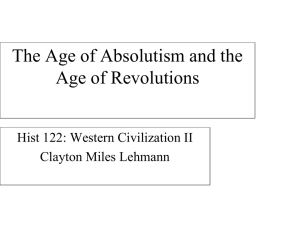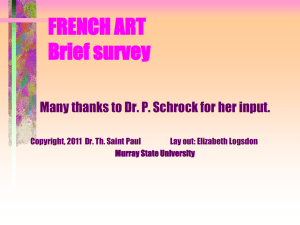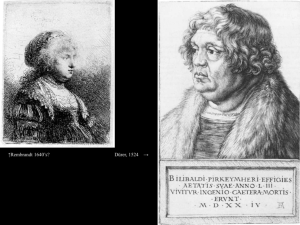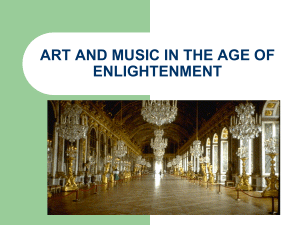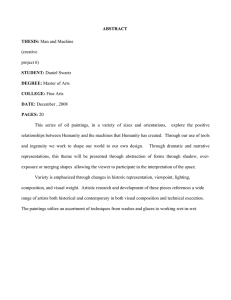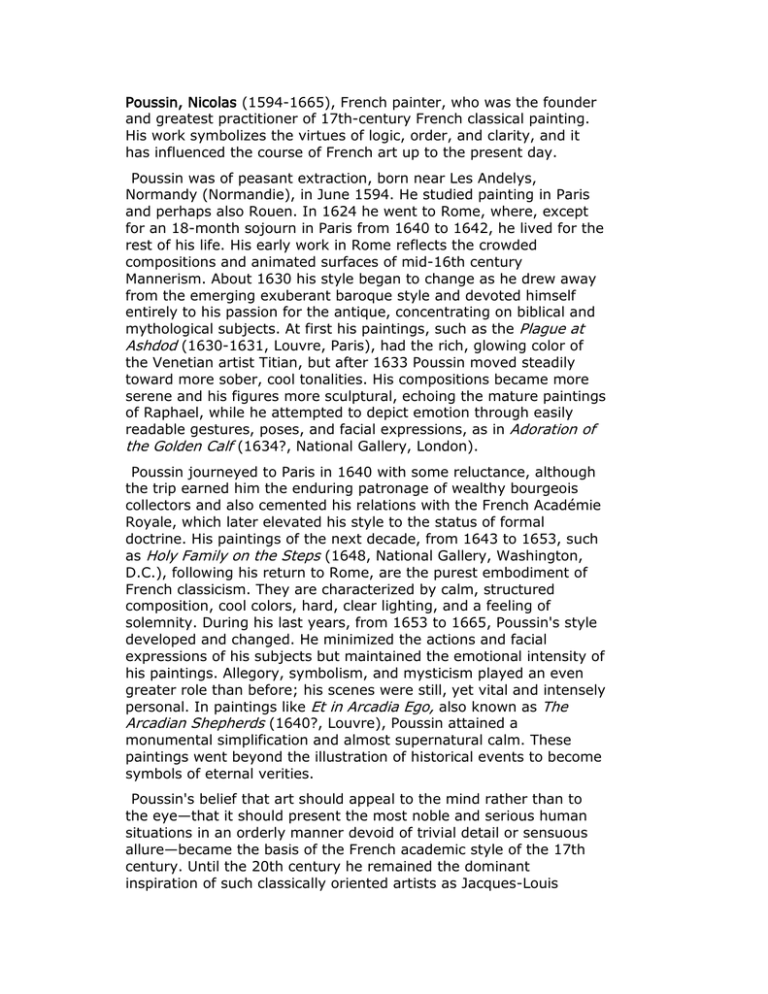
Poussin, Nicolas (1594-1665), French painter, who was the founder
and greatest practitioner of 17th-century French classical painting.
His work symbolizes the virtues of logic, order, and clarity, and it
has influenced the course of French art up to the present day.
Poussin was of peasant extraction, born near Les Andelys,
Normandy (Normandie), in June 1594. He studied painting in Paris
and perhaps also Rouen. In 1624 he went to Rome, where, except
for an 18-month sojourn in Paris from 1640 to 1642, he lived for the
rest of his life. His early work in Rome reflects the crowded
compositions and animated surfaces of mid-16th century
Mannerism. About 1630 his style began to change as he drew away
from the emerging exuberant baroque style and devoted himself
entirely to his passion for the antique, concentrating on biblical and
mythological subjects. At first his paintings, such as the Plague at
Ashdod (1630-1631, Louvre, Paris), had the rich, glowing color of
the Venetian artist Titian, but after 1633 Poussin moved steadily
toward more sober, cool tonalities. His compositions became more
serene and his figures more sculptural, echoing the mature paintings
of Raphael, while he attempted to depict emotion through easily
readable gestures, poses, and facial expressions, as in Adoration of
the Golden Calf (1634?, National Gallery, London).
Poussin journeyed to Paris in 1640 with some reluctance, although
the trip earned him the enduring patronage of wealthy bourgeois
collectors and also cemented his relations with the French Académie
Royale, which later elevated his style to the status of formal
doctrine. His paintings of the next decade, from 1643 to 1653, such
as Holy Family on the Steps (1648, National Gallery, Washington,
D.C.), following his return to Rome, are the purest embodiment of
French classicism. They are characterized by calm, structured
composition, cool colors, hard, clear lighting, and a feeling of
solemnity. During his last years, from 1653 to 1665, Poussin's style
developed and changed. He minimized the actions and facial
expressions of his subjects but maintained the emotional intensity of
his paintings. Allegory, symbolism, and mysticism played an even
greater role than before; his scenes were still, yet vital and intensely
personal. In paintings like Et in Arcadia Ego, also known as The
Arcadian Shepherds (1640?, Louvre), Poussin attained a
monumental simplification and almost supernatural calm. These
paintings went beyond the illustration of historical events to become
symbols of eternal verities.
Poussin's belief that art should appeal to the mind rather than to
the eye—that it should present the most noble and serious human
situations in an orderly manner devoid of trivial detail or sensuous
allure—became the basis of the French academic style of the 17th
century. Until the 20th century he remained the dominant
inspiration of such classically oriented artists as Jacques-Louis
David, Jean-August-Dominique Ingres, and Paul Cézanne. He died in
Rome on November 19, 1665.1
1"Poussin, Nicolas."Microsoft® Encarta® Encyclopedia 2001. © 1993-2000 Microsoft
Corporation. All rights reserved.


